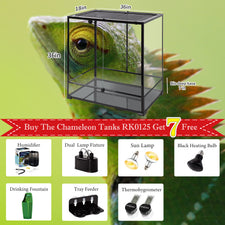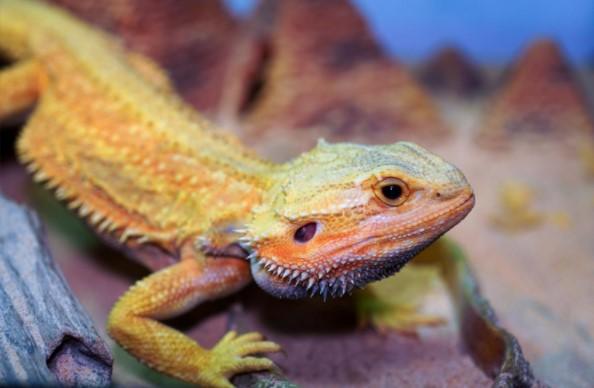Reptiles are becoming more and more popular as pets. A lot of people are starting to get bearded dragons as their pets. If you are thinking about getting a bearded dragon for a reptile pet, you need to know about taking care of them. They are known as one of the best exotic pets for kids, but they do require some work to maintain well. This blog lists everything that you need to know about taking care of your baby bearded dragon and how you can expect them to grow.
Baby Bearded Dragon Care
Selecting the Healthy Baby Bearded DragonWhile it’s never too late to get a bearded dragon, there are a few things you’ll want to consider, especially if you’re buying for the first time. The first thing you’ll want to do is make sure the dragon is healthy. Find a good breeder and do an interview with them, or ask for medical records from a previous owner as extra assurance.
After that, you’ll want to consider what you’re looking for. Some people prefer their dragons to be tame, while others enjoy dragons that have a lot of energy and activity. Healthy baby bearded dragons are very active and move around a lot. They like to climb, jump, and run. They have very clear eyes and are very healthy. Their vent, eyes, and nose must be clean.
Buy the Right Reptile TankIn order to own a baby bearded dragon, you need to make sure that you have the right living space. Most commonly, they’re kept in a reptile tank with a lid, which can range anywhere from 20 gallons to 120 gallons. The average should be at least 20 gallons or baby but remember: the bigger your tank, the more time and money you will have to spend on maintaining it, so start small and upgrade from there if you have to.
You can buy a tank or build your own. Whichever you choose, make sure it’s glass and not plastic or acrylic. A good rule of thumb is that if you can see through it, it’s not sturdy enough for your lizard.
Light SourceOne of the most important things to remember when owning a bearded dragon is that your dragon will need some type of UVB light. This means you will have to have either a UVB light hanging from your enclosure or a reptile lamp that you will put on the top of the enclosure. Some owners like to get creative and try to make their UVB lamp by placing a UVB bulb inside of an incandescent light bulb.
UV bulbs are rated in UVA/UVB light output (which just means the percentage of UVA and UVB light produced by the bulb) so you'll want to make sure that you're replacing your bulbs every 6 months to maintain the right levels. These correct levels will help your baby dragons in metabolizing and digesting food and growing at a healthy rate.
Proper SubstrateThe substrate is a layer of solid that is present on the floor of the tank. This could be sand, dirt, or some other material that you decide on. There are a variety of substrates available, ranging from pebbles to ceramic tiles. Slate tiles are generally the safest choice for small pets, like lizards and reptiles. Newspaper is also used by many owners.
Carpet is also another option. It is the layer of material at the bottom of your tank that holds the other material in place and absorbs the moisture that comes off of leaves, soil, etc. if you decide to use them. Just remember that the substrate is capable of molding and disintegrating. This is why it is important to replace it every once in a while.
Heat SourceBearded dragons are desert dragons, so heat is a must. Keeping them at the right temperature helps them be healthy and happy. They need to find a warm place to bask and then a cool place to hide and rest. A good way to keep them comfortable is to use a combination of a ceramic heat emitter and a light bulb to create the perfect temperature gradient. Bearded dragons are best kept at a temperature gradient of around 100-110 degrees Fahrenheit for their basking spot; and around 80 degrees F for their cool side.
FoodBaby bearded dragons can be tricky to take care of, especially when it comes to feeding them a healthy diet. To make sure your dragon stays happy and healthy, here's what you need to do. First, you need to research which types of meat and insects are best for them. Some feeder insects can be too big for baby bearded dragons and could choke them! Then, you need to make a schedule for feeding them. Bearded dragons tend to eat a lot, so make sure you're ready.
Make a schedule of giving 75% insects and meat and 25% veggies. Lastly, you should start to observe their behavior after eating. If they seem lethargic or aren't behaving normally, you may need to see a vet.
WaterOne of the most important parts of keeping a bearded dragon is making sure that you’re providing a suitable environment for them to live in. Unlike many other lizards, bearded dragons don’t require a ton of humidity, so it’s important to make sure that their cage has the right levels of moisture. One way to do this is to make sure that you’re giving them a shallow, cleaned dish of water to swim in 3 to 4 times per week. Not only does this give them a fun way to clean themselves and drink, but it also gives them the moisture that they need to stay healthy.
HandlingOne of the most important things to do with your baby bearded dragon is to spend quality time with them. You should spend at least 10-15 minutes everyday handling, playing with, and interacting with your bearded dragon. This will help strengthen your bond, making your bearded dragon more comfortable and content when they're around you.
This will also help you understand your bearded dragon's personality, needs, and quirks so that you can better take care of them. Just remember to go slowly and don't push your bearded dragon. Always make sure your baby bearded dragon is comfortable, and don't ever force them to do anything. These are important steps to building a positive bond with your bearded dragon.
Conclusion
As a reptile lover, you may want to bring one of these cute creatures to your home. Baby bearded dragons can be very adorable, but taking care of them is a challenging task. If you want to get a baby bearded dragon, you will need to prepare some things. First, you need to choose the right tank for your baby bearded dragon. You should have a 20-gallon tank for one baby bearded dragon. The tank should have a basking spot of 100-110 degrees and a cool side of 80-85 degrees. You will need to provide UVB lighting, food, water, and bedding. You will also need to provide a proper diet.











